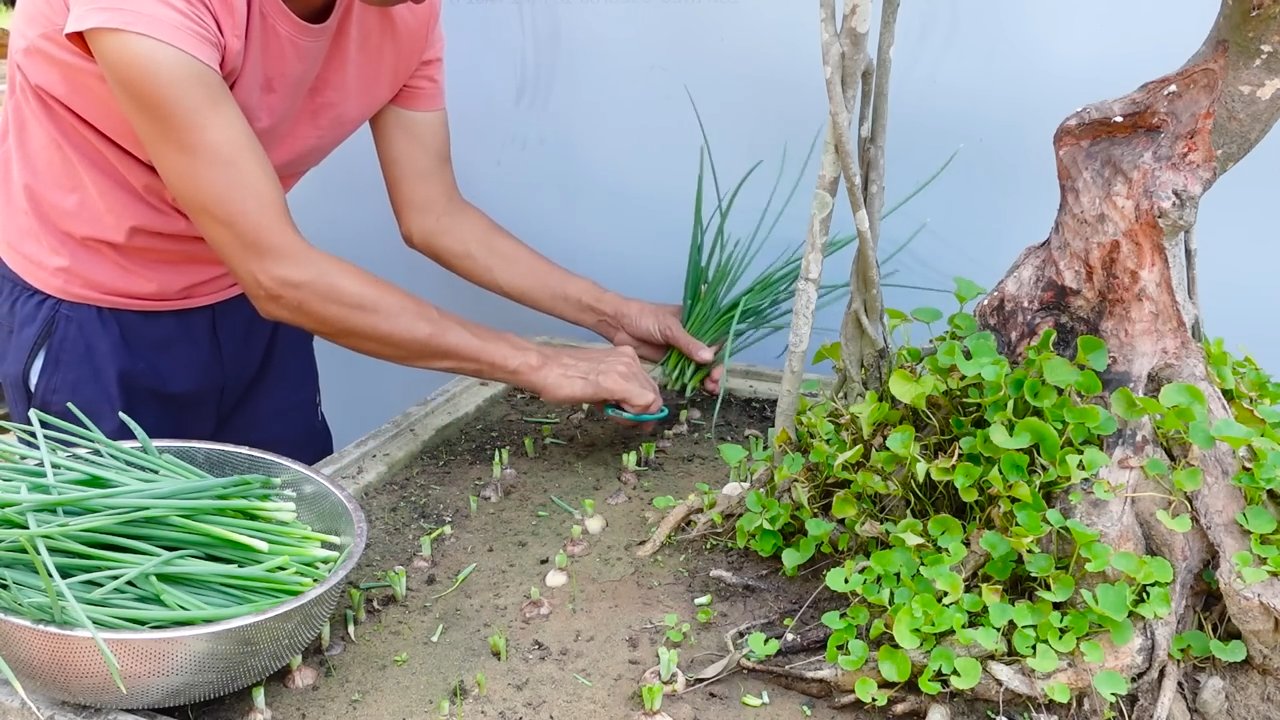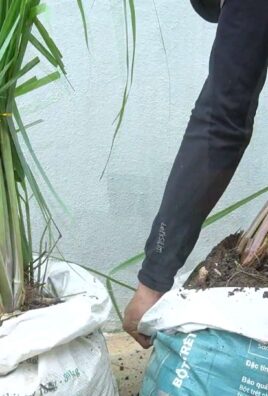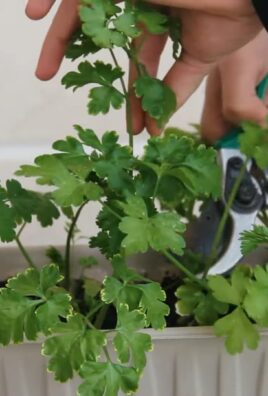Green Onion Garden DIY: Your Kitchen’s Never Been So Fresh!
Have you ever tossed the root ends of your green onions, thinking they were destined for the trash? Well, prepare to have your mind blown! I’m about to share a super simple, incredibly rewarding Green Onion Garden DIY trick that will keep your kitchen stocked with fresh, flavorful green onions practically forever. Forget those sad, wilted bunches from the grocery store – we’re talking vibrant, homegrown goodness right at your fingertips!
The practice of regrowing vegetables isn’t new; it’s a time-honored tradition passed down through generations, especially during times of scarcity. Think victory gardens during wartime or resourceful grandmothers stretching their grocery budgets. It’s a testament to human ingenuity and our connection to the earth. But even without a historical context, the sheer convenience and cost-effectiveness of this Green Onion Garden DIY makes it a must-try for any home cook.
Why do you need this DIY trick? Because it’s ridiculously easy, saves you money, reduces food waste, and adds a touch of green to your kitchen! Imagine snipping fresh green onions to garnish your tacos, salads, or soups whenever you need them. No more last-minute grocery runs or throwing away unused portions. Plus, it’s a fantastic way to introduce kids to the wonders of gardening and sustainability. So, let’s ditch the disposables and embrace the joy of regrowing – your taste buds (and your wallet) will thank you!

Regrowing Green Onions: A Beginner’s Guide to an Endless Supply
Hey there, fellow gardening enthusiasts! Are you tired of buying green onions only to use a tiny bit and watch the rest wilt away in your fridge? Well, I’ve got a super easy and rewarding DIY project for you: regrowing green onions from scraps! It’s practically free, incredibly simple, and gives you a continuous supply of fresh green onions right at your fingertips. Trust me, once you start, you’ll never look at a bunch of green onions the same way again.
What You’ll Need
Before we dive in, let’s gather our supplies. The beauty of this project is that you probably already have most of what you need!
* Green Onions: Obviously! You’ll need the green onions you bought from the store or market. Look for ones with healthy-looking roots still attached. The more roots, the better the chances of success.
* A Glass or Jar: Any glass or jar will do, as long as it’s tall enough to hold the green onion roots and some water. A mason jar, a drinking glass, or even a recycled yogurt container works perfectly.
* Water: Tap water is fine!
* Scissors or a Knife: For trimming the green onions.
* Potting Soil (Optional): If you want to transplant your green onions to soil later for bigger, more robust growth.
* A Small Pot (Optional): For planting in soil.
* Sunlight: A sunny windowsill or a spot in your garden.
The Water Propagation Method: Step-by-Step
This is the easiest method, perfect for beginners. We’ll start by regrowing the green onions in water, and then we can decide later if we want to move them to soil.
1. Prepare the Green Onions: This is the most crucial step. Take your bunch of green onions and trim off the green parts, leaving about 1-2 inches of the white base with the roots attached. Don’t throw away the green parts you cut off! You can use them in your cooking right away. I usually chop them up and add them to salads, soups, or stir-fries.
2. Place in Water: Now, take your glass or jar and fill it with enough water to cover the roots of the green onions. Don’t submerge the entire white part; just the roots need to be in the water.
3. Arrange the Green Onions: Carefully place the trimmed green onion bases into the glass, root-side down. Make sure they are standing upright. If your glass is too wide and the green onions are falling over, you can use a rubber band to hold them together.
4. Find a Sunny Spot: Place the glass with the green onions on a sunny windowsill or in a well-lit area. Green onions need sunlight to grow, so make sure they get at least 6 hours of sunlight per day.
5. Change the Water Regularly: This is important to prevent the water from getting murky and to keep the roots healthy. Change the water every 1-2 days. I usually do it every morning when I’m making my coffee.
6. Watch Them Grow! Within a few days, you should start to see new green shoots emerging from the top of the white base. It’s so exciting to watch them grow! You’ll be amazed at how quickly they sprout.
7. Harvest Your Green Onions: Once the new green shoots are a few inches long, you can start harvesting them. Simply snip off the amount you need with scissors. The green onions will continue to grow, so you can harvest them repeatedly.
Transplanting to Soil (Optional)
While you can continue to grow your green onions in water indefinitely, transplanting them to soil can result in bigger, more robust plants. Here’s how to do it:
1. Choose a Pot: Select a small pot with drainage holes. The size of the pot will depend on how many green onions you want to plant together. A 4-6 inch pot is usually sufficient for a few green onions.
2. Prepare the Potting Soil: Fill the pot with good-quality potting soil. Make sure the soil is loose and well-draining.
3. Carefully Remove the Green Onions from the Water: Gently remove the green onions from the glass, being careful not to damage the roots.
4. Plant the Green Onions: Make a small hole in the soil for each green onion. Plant the green onions so that the white base is buried in the soil, and the green shoots are above the surface.
5. Water Thoroughly: After planting, water the soil thoroughly until water drains out of the drainage holes.
6. Place in a Sunny Spot: Place the pot in a sunny location, just like when they were in water.
7. Water Regularly: Keep the soil moist but not soggy. Water when the top inch of soil feels dry to the touch.
8. Fertilize (Optional): To encourage even more growth, you can fertilize your green onions every few weeks with a diluted liquid fertilizer.
Troubleshooting
Even with the simplest projects, sometimes things don’t go exactly as planned. Here are a few common issues you might encounter and how to fix them:
* Green Onions Not Growing: If your green onions aren’t growing, make sure they are getting enough sunlight. Also, check the water to make sure it’s clean and fresh. Sometimes, the green onions you bought from the store might just be too old or damaged to regrow. Try starting with a fresh bunch.
* Roots Turning Brown: Brown roots can indicate that the water is not clean enough or that the green onions are rotting. Change the water more frequently and make sure the roots are not submerged too deeply.
* Yellowing Leaves: Yellowing leaves can be a sign of overwatering or underwatering. Adjust your watering schedule accordingly. It could also mean they need more nutrients if planted in soil, so consider fertilizing.
* Slime on the Roots: If you notice a slimy substance on the roots, it’s likely a sign of bacterial growth. Rinse the roots thoroughly and change the water immediately. You might also want to add a drop of hydrogen peroxide to the water to kill the bacteria.
Tips and Tricks for Success
Here are a few extra tips to help you get the most out of your green onion regrowing project:
* Choose Healthy Green Onions: Start with the freshest green onions you can find. Look for ones with firm, white bases and healthy-looking roots.
* Don’t Overwater: Overwatering can lead to root rot. Make sure the soil is well-draining and only water when the top inch of soil feels dry.
* Rotate Your Green Onions: If you’re growing your green onions in a pot, rotate the pot regularly to ensure that all sides of the plant get equal sunlight.
* Experiment with Different Varieties: There are many different varieties of green onions, so experiment with different ones to see which ones grow best for you.
* Successive Planting: To ensure a continuous supply of green onions, start new batches every few weeks. This way, you’ll always have fresh green onions ready to harvest.
* Use Filtered Water: While tap water works fine, using filtered water can sometimes lead to better results, especially if your tap water is heavily chlorinated.
* Consider Hydroponics: If you’re feeling adventurous, you can try growing your green onions hydroponically. This involves growing them in a nutrient-rich solution without soil. There are many hydroponic systems available online, or you can even build your own.
Why I Love This DIY Project
I absolutely love this DIY project because it’s so simple, sustainable, and rewarding. It’s a great way to reduce food waste, save money, and have fresh green onions on hand whenever I need them. Plus, it’s just plain fun to watch them grow! It’s a fantastic project for kids too, teaching them about gardening and where their food comes from.
So, what are you waiting for? Grab a bunch of green onions and get started! You’ll be amazed at how easy it is to regrow them and enjoy a continuous supply of fresh, flavorful green onions. Happy gardening!
Conclusion
So, there you have it! Transforming kitchen scraps into a thriving green onion garden is not just a fun project; it’s a sustainable, cost-effective, and incredibly rewarding way to add fresh flavor to your meals. We’ve walked you through the simple steps, highlighting how easy it is to regrow green onions from the bulbs you’d normally discard. This isn’t just about saving a few dollars at the grocery store; it’s about connecting with your food, reducing waste, and enjoying the unparalleled taste of homegrown herbs.
Why is this DIY trick a must-try? Because it’s practically foolproof! Even if you don’t have a green thumb, green onions are incredibly resilient and forgiving. They require minimal effort and space, making them perfect for apartment dwellers, busy families, and anyone looking to add a touch of green to their lives. Imagine the satisfaction of snipping fresh green onions directly from your windowsill to garnish your soup, salad, or stir-fry. The flavor is brighter, the texture is crisper, and the knowledge that you grew them yourself makes every bite even more delicious.
But the benefits don’t stop there. By regrowing your own green onions, you’re actively reducing food waste and contributing to a more sustainable lifestyle. Think about all the green onion bunches that end up in the trash each year. This simple DIY project allows you to break that cycle and turn what would have been waste into a valuable resource.
Looking for variations? Absolutely! You can experiment with different containers, from repurposed jars and plastic containers to dedicated herb planters. Try using different types of soil or even growing your green onions hydroponically. You can also plant the regrown green onions in your garden for a continuous supply. Consider companion planting them with other herbs or vegetables that benefit from their presence, such as tomatoes or carrots.
Don’t be afraid to experiment and find what works best for you. The beauty of this DIY project is its flexibility and adaptability.
We wholeheartedly encourage you to give this Green Onion Garden DIY a try. It’s a small investment of time that yields big rewards in terms of flavor, sustainability, and personal satisfaction. Once you experience the joy of harvesting your own fresh green onions, you’ll wonder why you didn’t start sooner.
And most importantly, we want to hear about your experience! Share your photos, tips, and stories with us in the comments below. Let us know what worked well for you, what challenges you encountered, and any creative variations you came up with. Together, we can build a community of green onion growers and inspire others to embrace the joys of sustainable gardening. So, grab those green onion scraps, get your hands dirty, and let’s grow something amazing!
Frequently Asked Questions (FAQ)
How long does it take for green onions to regrow?
Generally, you’ll start to see new growth within a few days of placing the green onion bulbs in water or soil. Within a week or two, you should have a noticeable amount of new green shoots. The speed of regrowth can depend on factors like temperature, sunlight, and the overall health of the original green onions. Warmer temperatures and plenty of sunlight will encourage faster growth.
Can I regrow green onions indefinitely?
While you can regrow green onions multiple times from the same bulb, the quality and vigor of the regrowth may diminish over time. After several cycles, the green onions might become thinner or less flavorful. To maintain a consistent supply of high-quality green onions, it’s recommended to start with fresh bulbs periodically. You can also plant the regrown bulbs in soil to allow them to establish a stronger root system and potentially produce more robust growth.
What kind of soil is best for regrowing green onions?
Green onions aren’t particularly picky about soil, but they thrive in well-draining soil that is rich in organic matter. A good potting mix or a blend of garden soil, compost, and perlite will provide the nutrients and drainage they need. Avoid heavy clay soils, as they can retain too much moisture and lead to root rot. If you’re planting your regrown green onions in the garden, amend the soil with compost or other organic matter to improve its fertility and drainage.
How much sunlight do green onions need?
Green onions prefer full sun, which means at least six hours of direct sunlight per day. However, they can also tolerate partial shade, especially in hotter climates. If you’re growing your green onions indoors, place them near a sunny window or supplement with a grow light. Insufficient sunlight can result in leggy, weak growth.
How often should I water my regrowing green onions?
Keep the soil consistently moist, but not waterlogged. Water when the top inch of soil feels dry to the touch. Overwatering can lead to root rot, so ensure your container has good drainage. If you’re growing your green onions in water, change the water every few days to prevent bacterial growth.
Can I use fertilizer to help my green onions grow?
While not essential, fertilizing your green onions can promote faster and more vigorous growth. Use a balanced liquid fertilizer diluted to half strength every few weeks. Avoid over-fertilizing, as this can burn the roots. Alternatively, you can amend the soil with compost or other organic matter to provide a slow-release source of nutrients.
What if my green onions start to turn yellow or brown?
Yellowing or browning leaves can indicate a few different problems. Overwatering is a common cause, so make sure your soil is well-draining and that you’re not watering too frequently. Insufficient sunlight can also cause yellowing. Check for pests, such as aphids or spider mites, which can also damage the leaves. If you suspect a pest infestation, treat your green onions with an appropriate insecticide or insecticidal soap.
Can I eat the entire green onion, including the white bulb?
Yes, you can eat the entire green onion, including the white bulb and the green shoots. The white bulb has a slightly stronger flavor than the green shoots. When harvesting, you can either snip off the green shoots as needed or pull up the entire plant. If you pull up the entire plant, you can replant the bulb to regrow more green onions.
Are there any pests or diseases that affect green onions?
Green onions are generally resistant to pests and diseases, but they can occasionally be affected by aphids, spider mites, or onion thrips. These pests can be controlled with insecticidal soap or neem oil. Root rot can also be a problem if the soil is poorly drained or if the green onions are overwatered. To prevent root rot, ensure your container has good drainage and avoid overwatering.
Can I grow green onions indoors year-round?
Yes, you can grow green onions indoors year-round, as long as you provide them with sufficient light and water. Place them near a sunny window or supplement with a grow light. Keep the soil consistently moist, but not waterlogged. With proper care, you can enjoy a continuous supply of fresh green onions throughout the year.




Leave a Comment